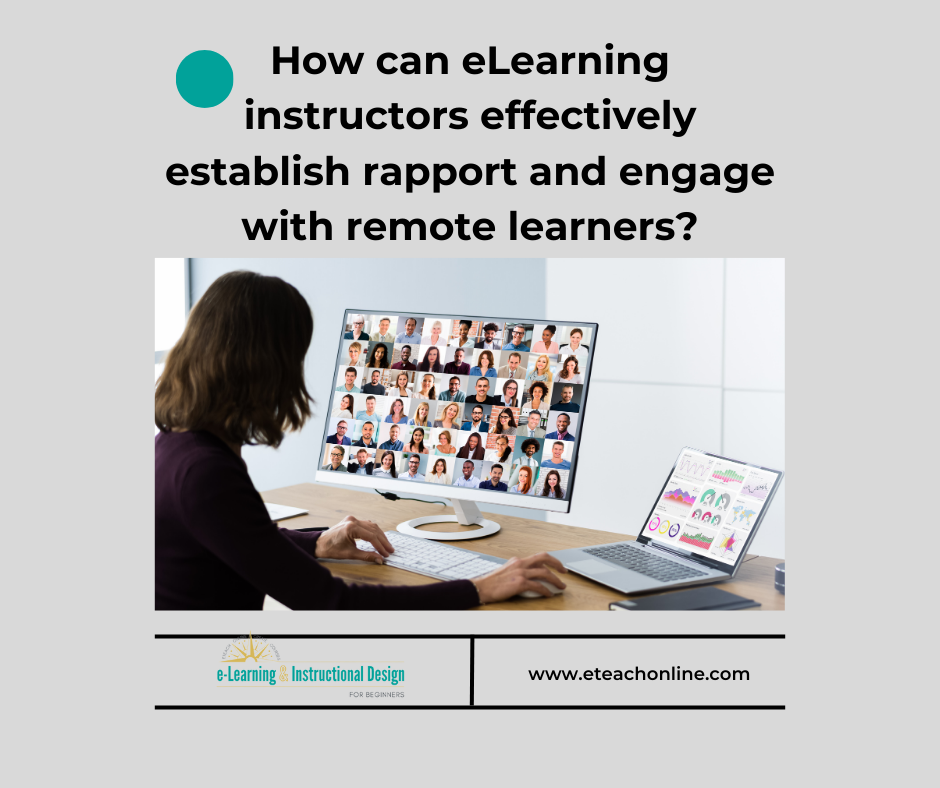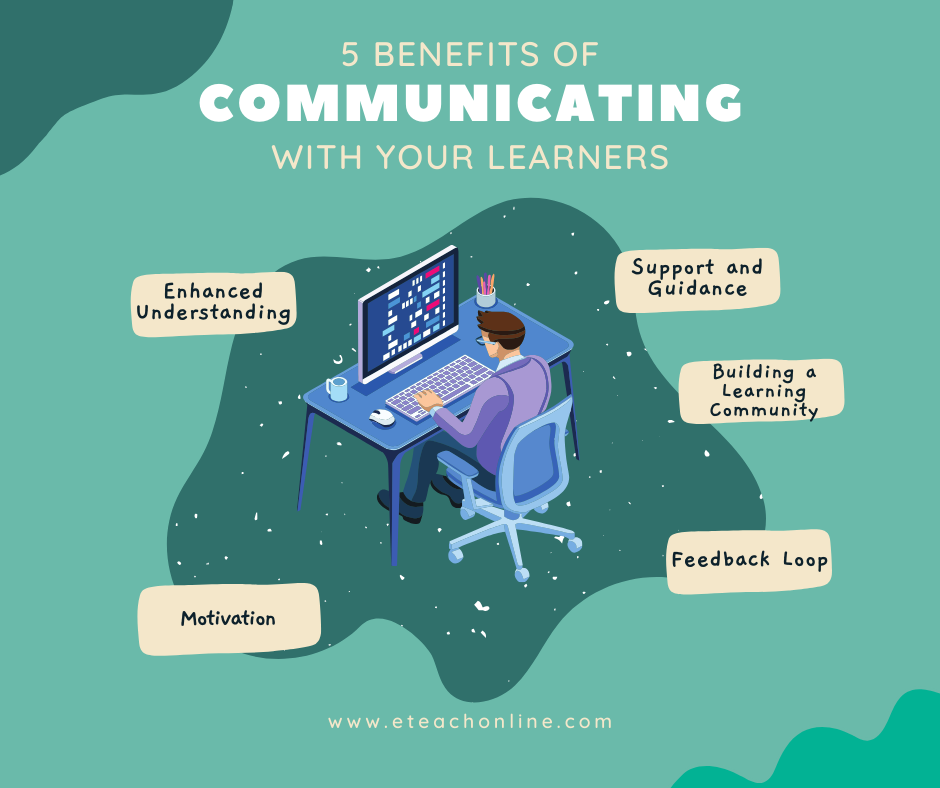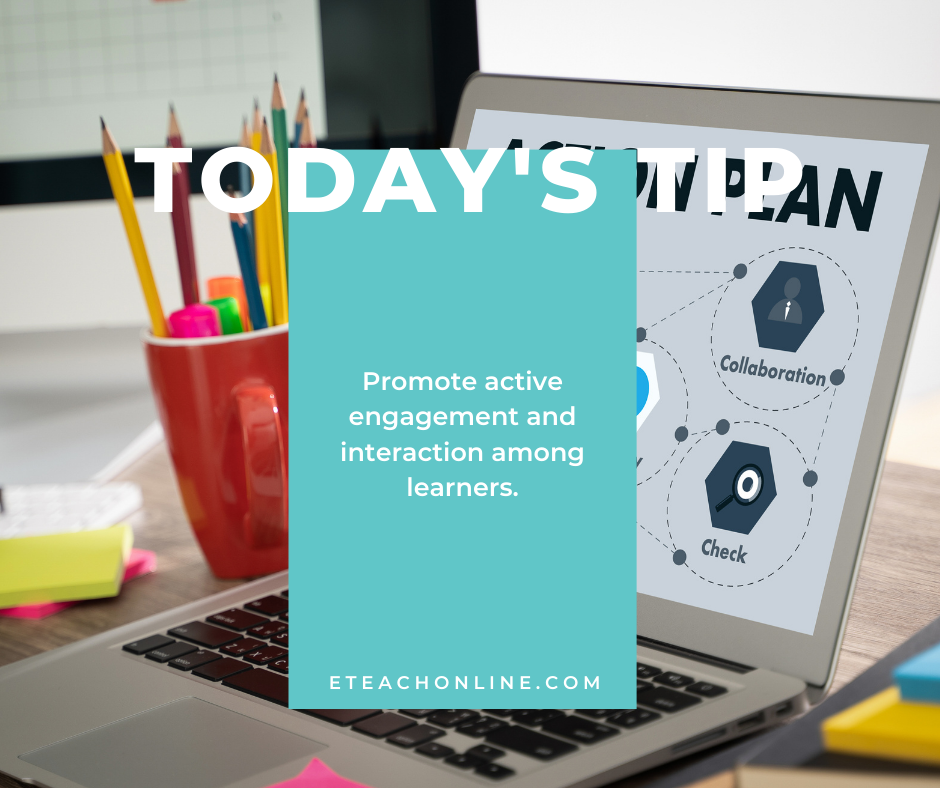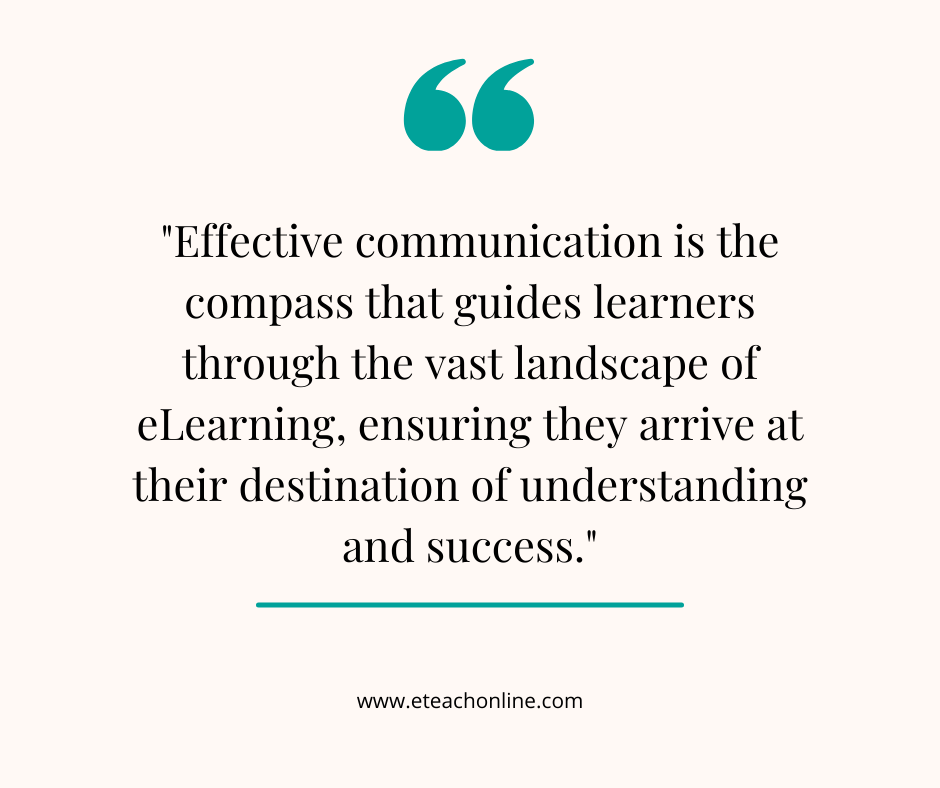Unlock the Episode: Listen and Download the Free MP3 from My Podcast Today!
SUMMARY
In the realm of online education, effective communication is the linchpin that holds the entire learning experience together. Whether you're an instructor or an instructional designer, understanding and implementing clear communication strategies in eLearning is paramount. Text-based communication remains the cornerstone of online courses, and it's imperative to ensure that your instructions and messages are crystal clear. Failing to do so can lead to frustration and confusion for your students, which ultimately hinders their learning progress.
In this blog post, we will explore ten essential communication strategies to foster a strong and meaningful connection with your eLearning students. Clear and efficient communication is not just a nice-to-have; it's a critical factor that can significantly improve student outcomes and overall satisfaction.
- Be Easily Reachable
Providing clear and easily accessible contact information is the first step in building an effective communication bridge with your students. Make sure your contact details are prominently displayed, and inform students about the expected response time, typically within 24 hours. This sets the right expectations and establishes trust from the outset.
- Utilize Announcements
Leverage the announcement section of your course management system to disseminate important information. This proactive approach can preemptively address common questions, reducing the flood of emails and ensuring that all students have access to vital updates.
- Participate in Discussion Forums
Engage with your students in the discussion forums. Your active participation not only provides valuable insights but also encourages students to participate more thoughtfully and contribute to the discussion more meaningfully.
- Identify Repeat Questions
Pay attention to repeated questions from students, as they often indicate areas of confusion. Address these concerns promptly, and consider revising your course materials to clarify these points proactively.
- Provide a Course Walkthrough
At the beginning of your course, offer a comprehensive course walkthrough. This may include a video tutorial on how to navigate the course and the learning management system. By setting clear expectations and explaining the course structure, you can alleviate potential confusion.
- Mind Your Netiquette
Online communication can be prone to misunderstandings due to the absence of non-verbal cues. Be cautious with your tone and ensure that your messages are clear and polite. A careful re-read can help avoid misinterpretations.
- Personalize Your Interactions
Taking notes on individual students, such as nicknames, hobbies, or interests, can help you personalize your interactions. Referencing these details in your responses can demonstrate that you value each student as an individual.
- Make Content Scannable
Format your course materials in a scannable way. Limit the text, use meaningful titles and headlines, and provide clear instructions in bullet points or numbered lists. Highlight essential keywords, phrases, and links to assist students in quickly locating important information.
- Establish Instructor Presence
Let your students get to know you on a personal level. Create a page that shares your interests and include personal audio or video messages to foster a sense of connection. Additionally, provide regular announcements and reminders to mitigate the feelings of isolation that students often experience in eLearning.
- Deliver Timely and Detailed Feedback
When grading assignments, provide feedback that is both timely and detailed. This human touch is vital for students, reinforcing their connection to you as their instructor. Be responsive to questions or concerns within 24 hours and maintain a positive, encouraging tone.
Incorporating these communication strategies into your eLearning courses will lead to a more engaged and satisfied student body. Remember, online education can sometimes feel isolating, so proactive and effective communication can help bridge the gap between students and instructors. Furthermore, keeping an open channel for feedback and making necessary adjustments based on student input will enhance the overall learning experience. As educators in the digital age, it's our duty to ensure that the eLearning environment is not just informative but also conducive to building strong connections and fostering student success.
INSPIRATIONAL QUOTES







TRANSCRIPT
Hello, and welcome to the eLearning and Instructional Design for Beginners podcast, where new and aspiring instructional designers start, grow, and advance their careers in instructional design and online learning development. I'm your host, Crystal Harper.
I'm a former school teacher who transitioned to instructional design, all while working full-time as a single mom. Would you like to become a successful instructional designer without the burden of earning another degree? Well then, let's get started.
Clear communication is an essential strategy in eLearning and instructional design because
of the fact that text is the most accepted form of communication in online courses. It is very frustrating when instructors don't ensure directions are clear. It takes time and effort to carefully plan out a course to avoid too much confusion. Effective communication in the online learning environment can improve student outcomes and satisfaction. In this course, you will learn about 10 strategies that will help you develop a strong connection with your students via online learning. It is imperative that you take into consideration the suggestions mentioned in this course, keeping up with frequent communication with your students. All of these suggestions will work in supporting the learning process.
Why is communication so important? First, we will discuss why communication in the online learning environment is so important. Of all the challenges in eLearning, lack of personal contact with the instructor is probably on the top of the list. Isolation, lack of support, and learner completion rates are frequent issues in eLearning. The best way to solve this problem lies in better communication amongst learners and instructors. Students need access to their instructor in order to address questions, concerns, and to receive feedback. Instructor or trainer communication with their students is essential and learner support must clearly be distinguished by the students. This issue will help students feel more connected and engaged in their learning. Students should receive consistent, timely, and detailed feedback. Instructors also need to be available to connect with their students through multiple formats such as email, Skype, or through the phone.
Learners must also be aware of instructor support, academic support, technical support, and administrative support. It is the instructor's responsibility to decipher between these different forms of communication and explain to the students his or her role in the process. Improving communication is easier said than done.
Now we will discuss strategies to help you connect with your learners. Provide clear, understood contact information. When your students are having a problem in the course, you don't want to add to their struggles by making it difficult for them to reach you. Your contact information needs to be displayed front and center. If you have a contact method that you prefer, highlight that. Also be sure to indicate to your learners an expected wait time before hearing back from you. Let the learners know that you will be in contact within 24 hours. This will help set expectations from the beginning.
Number two, use announcements. Communicate with students through the announcement section of the course. This saves the instructor time if they can anticipate questions that students may ask. This will also help eliminate the flood of emails that may come their way if students are confused.
Number three, participate in the discussion forums. Instructor involvement can make a huge impact in an online learning environment. Of course, a healthy discussion forum should be led by the learners and shouldn't rely on the instructors to stay alive. When learners know their ideas are being read by the instructor, it encourages them to try harder and contribute to the discussion more thoughtfully.
Number four, look out for repeat questions. One strategy that an instructor can use to anticipate if students are confused is to watch out for emails related to the same topic. If they receive two emails from students with questions about the same areas of concern, it is likely that many other students are just as confused.
Number five, provide a course walkthrough. Consider including a course walkthrough at the beginning of the course. This is a great way to give an outline of what the learner should expect from taking the course. Another effective way to do this is by including a video tutorial that explains how to navigate through the course and the learning management system.
Number six, be aware of netiquette. Online netiquette can sometimes be tricky and standards often change. This can cause misunderstandings between learners and instructors, especially when there has been no personal connection established. When communicating with your learners, remember that it is difficult for them to interpret your tone. A humorous comment can sometimes be misinterpreted as a snappy or irritated if they didn't realize the jest of your remark. Similarly, a quick and formal response can sometimes be read as cold or irritated.
It takes a lot of time and practice to phrase the messaging to your learners. By giving all of your responses a careful re-read can help avoid these possible misunderstandings.
Number seven, make note of specific details about your students. Another technique is to create a spreadsheet with notes on each learner. Suggestions to make note of includes nicknames, hometown, favorite hobbies, or sports teams. Your students will appreciate the extra effort and detail when incorporated into a response or feedback.
Number eight, provide scannable instructions. Information can be easily misinterpreted when delivered online. Instructions and course content should be formatted in a way they can be easily scanned and text should be written sufficiently to avoid anything that is not necessary. It is suggested to limit text by 50%, making all paragraphs short and to the point. Information that is crucial and not directly related should be placed on the sideline but not too ambiguously. Instructions should also include a meaningful title and headlines and subheadings. It is also a good idea to highlight essential keywords, phrases, and links.
Directions for assignments should be arranged into bullet points or a numbered list. Rubrics also need to be provided for each of the assignments and examples of exemplary work for students to refer to for assessment. Use clear fonts and colors to help students recognize important information. Consider setting up course links in a manner that allows students to easily navigate the site. If the course layout is confusing, students have a right to reach out for help, but this
also places a burden on the instructor's time. To ensure this doesn't happen, instructors should build their courses with care and with the understanding that a well-thought-out course design may take longer to develop on the front end, but it will save you time and help you better manage your students on the back end.
Students also need to have a place to ask questions when they don't understand something. At the bottom of each assignment page, the student should be given a place to write any questions or comments on that specific assignment. This can also help eliminate the potential of students asking the same question multiple times, as we discussed earlier, as well as increase social connections among the students. No matter what an instructor does, however, students will still have questions about content or may be confused about how to manage their online learning space. It is the instructor's job to make sure students have any resources they may need.
Students tend to have the most issues during the first two weeks of classes, so instructors should give them resources within that time frame to help them get acclimated. This includes a syllabus or welcome letter that contains course protocols, contact information, web resources, LMS support, and a course schedule. This will help students manage their own time.
Nine, instructor presence. Students need to feel a personal connection with their instructor, especially in an online learning environment. One way to accomplish this is by including a page that tells the students about who you are, your interests, and hobbies.
In this page, you should also include either a personal video, audio message, and or photos to help represent who you are as a person. Another way to support teacher immediacy at the beginning of each module is to provide a personal audio message explaining what the students can expect to learn in that particular module. The messages should be presented in a way that makes the students feel excited to learn the new content and that the instructor is right there with them if they need any additional help. You should also be sure to have a good messaging system that is checked regularly to be able to interact with the students and other faculty members.
One of the biggest problems with e-learning is students often feeling isolated, which leads to loss of motivation. The students in the course should be provided with weekly announcements and reminders to help support this issue as well.
Ten, providing feedback. In addition, you need to provide timely and detailed feedback when grading assignments in an online course. The students will feel connected to their instructor if they frequently receive positive and constructive feedback. Of course, providing feedback can be time-consuming, but the learners really need to know that someone is looking at the work they are doing.
It can be very discouraging for a student to feel as if their work is only being reviewed by a robot and not a living person. Also keep a positive attitude. Give direct feedback to all students, addressing them as individuals and by name. Also remember to respond to students' questions or concerns within 24 hours.
In addition, instructor presence can be emphasized using personal made videos and audio messages for feedback on assignments. Post Grades Regularly This is especially important in an online course to help keep students on the same page with how they are currently doing, which in turn can aid in retaining students in the class. Staying connected with your online learners means always responding to your learners in a timely manner in terms of their questions and concerns. It also means to show your presence by participating in online discussions and giving students timely feedback on their comments and work. Also, be sure to keep the course outline consistent with the received feedback and make changes to the course midstream to incorporate the feedback received from the students through various communication channels.
In conclusion, if you wish to develop a strong connection with your students via online learning, then you must take into consideration the suggestions mentioned in this course. The 10 strategies you learned about in this course includes 1. Provide clearly understood contact information 2. Use announcements 3. Participate in the discussion forums 4. Look out for repeat questions 5. Provide a course walkthrough 6. Be aware of netiquette 7. Make note of specific details about your students 8. Provide scannable instructions 9. Always include instructor presence 10. Provide detailed feedback If you keep up frequent communication with your students, all of these suggestions will work in the learning process. So now it is time for you to take action.
As you create your eLearning course or are evaluating an already created course, keep in mind these 10 strategies on how to communicate with your eLearning students.
JOIN THE
eLearning and Instructional Design for Beginners Community
- In-depth courses & training
Access my rapidly growing library, attend monthly live training & accountability support groups
- Exclusive tools & members-only discounts
Tools, templates, downloads, checklists and more - plus receive special perks & discounts
- Supportive community & network
Feedback and support from fellow instructional designers, career-driven business owners, and experts who will keep you on track
Get Your Software Toolkit for Instructional Designers
Tools & processes that will help you plan, build, and grow your instructional design career and freelance business.



